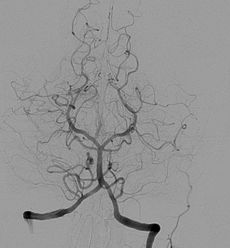- Cerebral angiography
-
Cerebral angiography Intervention
Cerebral angiogram showing a transverse projection of the vertebrobasilar and posterior cerebral circulation.ICD-9-CM 88.41 MeSH D002533 Cerebral angiography is a form of angiography which provides images of blood vessels in and around the brain, thereby allowing detection of abnormalities such as arteriovenous malformations and aneurysms. It was pioneered in 1927 by the Portuguese physician Egas Moniz at the University of Lisbon, who also helped develop thorotrast for use in the procedure.[1]
Typically a catheter is inserted into a large artery (such as the femoral artery) and threaded through the circulatory system to the carotid artery, where a contrast agent is injected. A series of radiographs is taken as the contrast agent spreads through the brain's arterial system, then a second series as it reaches the venous system.
For some applications[citation needed] this method may yield better images than less invasive methods such as computed tomography angiography and magnetic resonance angiography. In addition, cerebral angiography allows certain treatments to be performed immediately, based on the its findings. If, for example, the images reveal an aneurysm, metal coils may be introduced through the catheter already in place and maneuvered to the site of aneurysm; over time these coils encourage formation of connective tissue at the site, strengthening the vessel walls.
In some jurisdictions, cerebral angiography is required to confirm brain death.[citation needed]
See also
References
- ^ Tondreau, R. (1985) Egas Moniz 1874-1955. Radiographics, 5(6):994-997
Surgery, Nervous system: neurosurgical and other procedures (ICD-9-CM V3 01–05+89.1, ICD-10-PCS 00-01) Skull CNS thalamus and globus pallidus: Thalamotomy · Thalamic stimulator · Pallidotomy
ventricular system: Ventriculostomy · Suboccipital puncture · Intracranial pressure monitoring
cerebrum: Psychosurgery (Lobotomy, Bilateral cingulotomy) · Hemispherectomy · Anterior temporal lobectomy
pituitary: Hypophysectomy
hippocampus: Amygdalohippocampectomy
Brain biopsyCerebral meningesSpinal cord and roots (Cordotomy, Rhizotomy)
Vertebrae and intervertebral discs: see Template:Bone, cartilage, and joint proceduresCT head · Cerebral angiography · Pneumoencephalography · Echoencephalography/Transcranial doppler · MRI of brain and brain stem · Brain PET · SPECT of brain · MyelographyDiagnosticPNS Sympathetic nerves or gangliaNerves (general)DiagnosticCategories:
Wikimedia Foundation. 2010.

